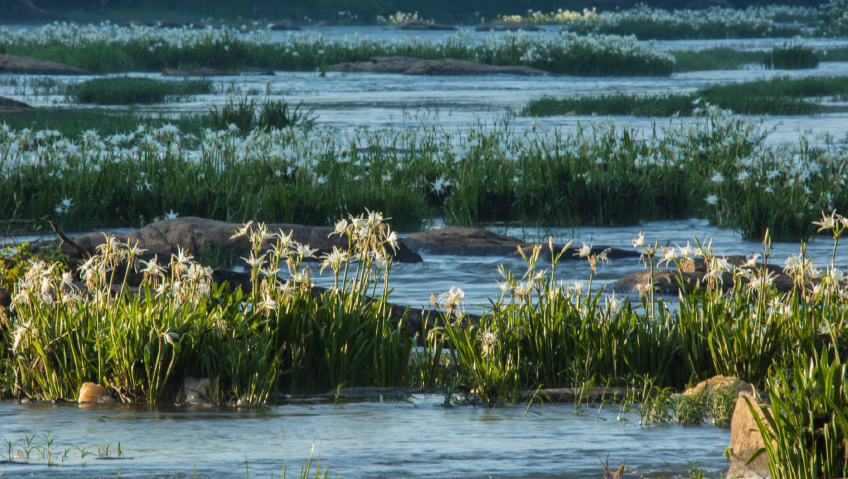We recently enjoyed a wide-ranging interview with Steve Bellamy, CEO, and Mary Ellen Davies, Director of Development at Confederation Centre of the Arts in Charlottetown. They spoke about the Centre’s history, growth, and development; its impact as a tourist draw and economic driver; current programming; and strategic plans for renewal and transformation.
The Centre stands next to Province House, site of the 1864 Charlottetown Conference which led to Canadian Confederation in 1867. The 1864 Conference also led to the Centre’s opening by Queen Elizabeth II, on October 6, 1964, the 100th anniversary of the Conference.
It was the first of several Canadian cultural institutions built in Canada whose openings coincided with the 100th anniversary of Confederation itself in 1967 or within a few years thereafter, such as the National Arts Centre in Ottawa in 1969. “But this institution was unique in that each province contributed $0.15 per capita, a figure matched by the federal government, to build the Centre with 30 cents from every Canadian,” Bellamy says.
The architect for Confederation Centre of the Arts was Dimitri Dimakopoulos, whose modern Brutalist design was selected from 47 submissions. Its pavilions include a 1,100-seat theatre on two levels, with state-of-the-art technology to support world-class productions. In 2022 it was renamed the Sobey Family Theatre in recognition of longstanding support from the Sobey family since the 1960s, and their recent $1.25 million Leadership Gift toward the Centre’s $65 million revitalization project. The renovation is being designed by the architectural firm of Abbott Brown, with work expected to begin in Fall 2024.
The Centre also houses a national art gallery, an outdoor amphitheatre, the multi-purpose 270-square-metre Memorial Hall, and until recently, the provincial library, which has moved across the street to the former post office building, providing expansion opportunities for programming in the vacated South Pavilion.
Musicals and more
Confederation Centre of the Arts has developed approximately 85 original musical theatre productions since opening in 1964. In 2022, it produced and presented the world premiere of Tell Tale Harbour, a musical theatre adaptation of the Ken Scott film, The Grand Seduction. The show starred Canadian singing legend Alan Doyle and propelled box office sales to the highest level in the Centre’s history. Other notable original productions have included Evangeline, Belles Soeurs, Dear Rita, The Dream Catchers, and Epekwitk Mi’kmaq Voices, to name a few.
Best known internationally is Anne of Green Gables–The Musical™, based on the 1908 novel by Lucy Maud Montgomery. This legendary musical premiered on The Charlottetown Festival main stage in 1965 and went on to become the world’s longest-running annual musical, performed each year until 2019, with performances in 2020 and 2021 cancelled due to COVID-19.
The long-time favourite returned in 2022 and will continue to be presented biennially, with the next performance in 2024 coinciding with the 150th anniversary of Lucy Maud Montgomery’s birth and the 60th anniversary of the Centre’s opening. But the iconic musical, which has toured Canada and presented a lively facet of Canadian culture to audiences in London, New York, Adelaide, and at the 1970 World’s Fair in Osaka, is far from being the only one, as the Centre continues to present new work .
In the 1970s, to increase performance space, the Centre acquired a movie theatre across the street and turned it into The MacKenzie Theatre, a 180-seat cabaret-style venue now jauntily renamed The Mack.
Although the theatre was originally only opened in summer for The Charlottetown Festival, and closed in winter, that eventually changed with other performances offered year-round—dance, comedy, and concerts have featured diverse artists ranging from Blue Rodeo, Alan Doyle, and Rick Mercer, to the P.E.I. Symphony Orchestra, Colin James, and Matt Anderson.
Other activities, including entertainment in the outdoor amphitheatre, dance and music theatre education, the Heritage Players Historic Walking Tours, a summer Young Company for theatre, The Dream Catchers, a Canada 150 Signature Event which celebrated Indigenous culture, and the annual Symons Medal Presentation and Lecture, are initiatives that fully live up to the Centre’s mandate to offer compelling and culturally relevant programming.
Economic impact
Bellamy says that pre-pandemic, the Centre completed an economic and cultural impact study. “Four big numbers came out of that report,” he shares. “We have an impact of $27 million to the provincial GDP; we create $6.4 million in tax revenue, $16.4 million in labour income, and more than 400 full-time equivalent jobs. The Centre is a huge economic driver.
“The Centre brings about 1000 people downtown every day in the summer, people who dine at one of the dozens of restaurants within three or four blocks of the centre. I think people don’t expect an arts organization to have such a big economic impact, but that’s one of the unique things about Confederation Centre of the Arts—with the art gallery and theatre, we are a driver of a lot of tourist activity, and we are happy to play our part alongside the many other incredible businesses and attractions in Charlottetown and throughout P.E.I.”
In 2008, the Centre, which annually attracts more than 100,000 patrons to performances, gallery exhibitions, heritage programs, and other events, received the Business of the Year Award from the Tourism Industry Association of Canada.
A silver lining
Although main stage productions were cancelled in 2020 and smaller shows were offered in 2021, some departments at the Centre remained open, providing activities in the outdoor amphitheatre and the Confederation Centre Art Gallery.
The Art Gallery has six exhibition spaces on three levels. “The Centre houses a significant permanent collection of contemporary Canadian art from 1964 to today,” Bellamy says, speaking of the collection of 17,000 works—paintings, drawings, prints, photographs, sculptures, documents, and digital works. The collection is featured in curated exhibitions, installations, and academic or educational events throughout the year.
Adds Davies, “Another part of our pandemic story was the generosity of our sponsors who stuck with us, even when we couldn’t do certain programming. We have sponsors who are from P.E.I. and national organizations supporting us, who supported us through the pandemic.”
Work did continue during the pandemic with the downtime used “to accelerate the Centre’s digital capacity in terms of high-quality video production and online content, and that is a silver lining because now we have strong capacity in that area,” Bellamy shares. “The pandemic also provided us with time to consider the future, our identity as a National Historic Site, and the role we play in Canada.”
Renewal and transformation
“We did a lot of soul searching,” he continues, “and the Centre landed on a new direction for our role in the national cultural landscape. Whereas the origins of Confederation Centre of the Arts were as a monument to the 1864 Conference and the Fathers of Confederation, our current role is to facilitate the interpretation of Confederation and the evolving identities in Canada, through the arts and through convening for discourse such as we do during the Symons Medal Presentation and Lecture,” he says.
“The Centre empowers artists from all cultural communities, with particular attention to Indigenous voices and those of newcomers to Canada. We want to ensure all communities have a voice on these stages, in the art galleries, and in conversation with one another. What we heard when we brought stakeholders together defined a direction which builds on past successes and charts a path for the future.”
Three areas of importance emerged following these discussions. Firstly, it was agreed that the Centre needs to expand its arts education programs, which will be done through the establishment of an Arts Academy that will house existing programs in dance and musical theatre as well as new programs for production skills, arts administration, cultural management, and other forms of training in the cultural sector. Professional training programs will vary in duration from one or two weeks to months-long residencies.
Secondly, the discussions identified that the Centre needs to do more Heritage programming. The starting point for this is the Symons Medal Presentation and Lecture, named in honour of Thomas Symons, the founding president of Trent University and a leading scholar in Canadian studies and human rights. The Symons Medal was launched in 2004 and is awarded annually to someone who has made a significant contribution to Canadian life in any field— including politics, science, art, or literature. Past winners include Bob Rae, David Suzuki, Louise Arbour, Murray Sinclair, and Antonine Maillet.
2023 marks the 19th anniversary of the Symons Medal, and the program has been expanded to include the Charlottetown Forum. This two-day gathering following the Symons Medal presentation will provide an opportunity for the public to gather with leaders from across the country to discuss issues of importance to all Canadians such as reconciliation, the environment, the economy, and how we move forward successfully. Dates of the inaugural Charlottetown Forum are November 9-10, 2023.
Thirdly, it was determined that the Centre can play a more significant role in the creation of new and original work for theatre and art in Canada. An Arts Innovation Hub will be established by re-organizing the former library space and adding a significant extension onto the South Plaza along Richmond Street. Changes to the building are being done with care, to introduce natural elements of wood and light while still maintaining the historic integrity of the original structure. The spaces created will facilitate theatre creation spaces for development of new theater work, as well as artist-in-residence studios and new learning spaces for community programming in visual and performing arts education.
Building on success
“It’s ambitious and exciting,” Bellamy says, “but what I like most about it is that these priority areas came from conversations with stakeholders in the local and national community, including staff here at the Centre, who provided critical input about how we can address decades-old challenges such as insufficient learning spaces or accessibility barriers.”
Concerning the facility itself, the designs call for retrofitting the building to make it more energy-efficient, with significant interventions such as solar panels, solar chimneys, and new insulation and HVAC systems that meet modern environmental standards. In the 1960s, mobility issues were not a priority, and as a result, there exist in the present-day Centre too many barriers to accessibility. The architects are working to meet Rick Hansen Foundation standards for Accessibility, adding elevators, ramps, and street level entry, and including auditory and visual enhancement for hearing- and visually-challenged guests. The Centre will raise significant private funds for the renovations and has also applied to federal, provincial and municipal governments for investment into the project.
“The architectural designs include significant reduction of GHG (greenhouse gas) emissions and improvements to energy efficiency, and we intend to share information about the improved carbon footprint of the site with visitors as a permanent feature,” Davies says. This is another way the Centre is showing leadership in environmental sustainability, an issue important to all Canadians.
The Charlottetown Festival, Summer 2023
While these plans are developing, summer is here and so are the tourists, heading across the Confederation Bridge to P.E.I. and downtown Charlottetown.
Running all summer in the Sobey Family Theatre are two plays: MAGGIE is a new Canadian musical co-created by award-winning recording artist Johnny Reid and Matt Murray. The originating producer of Come From Away, Michael Rubinoff, is producing MAGGIE with Reid. Confederation Centre of the Arts is presenting MAGGIE in partnership with Theatre Aquarius in Hamilton, Ontario, where it premiered in April.
Also in the Sobey Family Theatre is The Play that Goes Wrong, which has been hugely successful in London’s West End and off-Broadway in New York. The play stars P.E.I. actors in the leading roles while introducing never-before-seen technical trickery to the stage!
The Centre’s cabaret venue, The Mack, boasts two cabaret-style shows: The Music of Johnny & June (Johnny Cash and June Carter), starring Island talents Jacob Hemphill and Melissa MacKenzie, and I’m Every Woman, a musical revue featuring several talented singers performing inspired songs of legendary artists like Aretha Franklin, Dolly Parton, Whitney Houston, and more.
Visitors to Confederation Centre Art Gallery are in for an unparalleled treat in summer 2023 with the presentation of Generations: The Sobey Family and Canadian Art exhibition. This exhibition, featuring notable pieces from the private collections of several Sobey family members, was curated by the McMichael Canadian Art Collection and has been touring significant galleries across Canada.
“This important collection includes significant work by a number of Canadian masters including members of the Group of Seven, Emily Carr, Kent Monkman, and Jean-Paul Riopelle, among others,” Bellamy says. “We’re extremely excited to be presenting it here at the Confederation Centre Art Gallery for the entire summer.”
For this cultural institution, the summer ahead—and the future—certainly look bright indeed.






